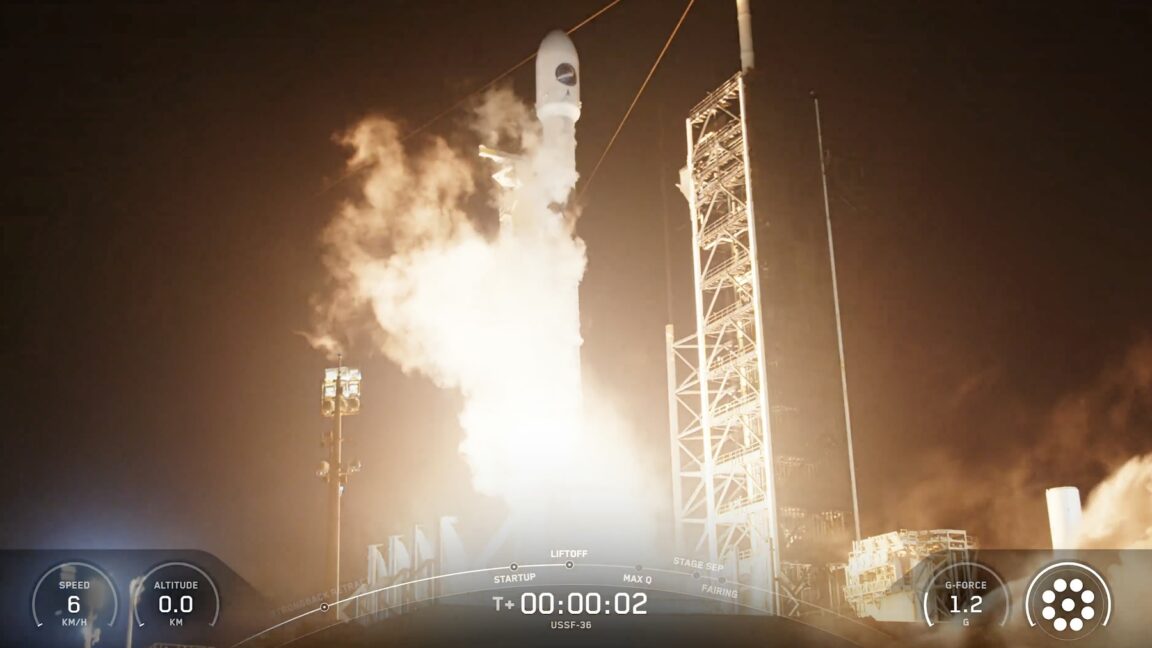Science
US Military Launches X-37B Spaceplane for Quantum Navigation Mission

The US military’s reusable spaceplane, the X-37B, successfully launched into orbit on Thursday night, beginning a mission focused on demonstrating advanced navigation technologies. Lifted by a SpaceX Falcon 9 rocket from the Kennedy Space Center in Florida at 23:50 EDT (03:50 UTC Friday), this marks the eighth flight of the X-37B since its inception in April 2010.
The mission’s highlight is a navigation experiment featuring what the Space Force describes as the “world’s highest performing quantum inertial sensor ever used in space.” This sensor aims to enhance spacecraft navigation capabilities without dependence on traditional GPS signals, crucial in scenarios where GPS may be compromised.
The Falcon 9 rocket executed a successful launch, steering northeast from Florida’s Space Coast. After detaching, the rocket’s first stage booster made a targeted landing at the nearby Cape Canaveral Space Force Station, while the upper stage propelled the X-37B into low-Earth orbit. In a press release early Friday, Space Force officials declared the launch a resounding success.
The X-37B program includes two Boeing-built spaceplanes resembling smaller, uncrewed solar-powered versions of NASA’s retired space shuttles. Managed by the Air Force Rapid Capabilities Office in collaboration with the Space Force, these spaceplanes serve as technological testbeds, transporting experiments to and from space.
While many payloads remain classified, officials disclose a few unclassified experiments with each mission. Previous flights of the X-37B have successfully deployed small satellites into orbit, subsequently landing at either Kennedy Space Center or Vandenberg Space Force Base in California.
Advancing Navigation Technologies
On this mission, the X-37B carries instrumentation to showcase quantum navigation abilities and a laser inter-satellite relay terminal. This terminal enables the spaceplane to establish connections with other spacecraft in orbit. The quantum sensor aims to facilitate accurate navigation in environments lacking GPS signals, detecting rotation and acceleration of atoms without reliance on satellite networks.
The significance of GPS cannot be understated; initially developed for military purposes, it has become essential for civilian applications ranging from commercial aviation to everyday navigation. However, its vulnerabilities make it a target for jamming and spoofing, especially in geopolitical conflicts like those in the Middle East and Ukraine.
Recognizing the critical need for reliable navigation, the Space Force emphasizes that the quantum sensor experiment will test technology suitable for “GPS-denied environments.” This capability could prove invaluable for deep space missions around the Moon or other celestial bodies, where traditional GPS signals are unavailable.
The quantum experiment on the X-37B is spearheaded by the Defense Innovation Unit (DIU) and the Office of the Undersecretary of Defense for Research and Engineering. Collaborating companies, Vector Atomic and Honeywell Aerospace, developed an atomic gyroscope designed for spaceflight, which offers enhanced motion sensing compared to conventional gyros.
Lt. Col. Nicholas Estep, an Air Force engineer overseeing the DIU’s emerging technology portfolio, stated, “Quantum inertial sensors are not only scientifically intriguing, but they also have direct defense applications. If we can field devices that provide a leap in sensitivity and precision for observing platform motion over what is available today, then there’s an opportunity for strategic gains across the DoD.”
Continuous Innovation in Space Operations
The X-37B spaceplanes have accumulated over 4,200 days in orbit, equivalent to roughly 11-and-a-half years. Most of this time has been spent in secrecy. The previous flight, known as Mission 7, concluded in March after a record-setting 14-month mission, reaching an altitude of approximately 25,000 miles (40,000 kilometers).
This high-altitude, elliptical orbit required a Falcon Heavy rocket for additional propulsion. In the mission’s final phase, ground controllers commanded the X-37B to perform an “aerobraking” maneuver, demonstrating the spacecraft’s ability to adjust its orbit in preparation for reentry.
Now, in Mission 8, the X-37B is back in low-Earth orbit, hosting experiments in quantum navigation and laser communications. These missions, which few anticipated when the X-37B first took to the skies, illustrate a significant evolution in space technology.
The laser communication experiments will involve using optical inter-satellite links with commercial satellite networks in low-Earth orbit, likely referring to SpaceX’s Starlink or Starshield satellites. This technology promises faster data transmission rates and enhanced security against eavesdropping.
General Chance Saltzman, the Space Force’s chief of space operations, remarked, “The laser communications experiment will mark an important step in the US Space Force’s ability to leverage proliferated space networks as part of a diversified and redundant space architecture. In so doing, it will strengthen the resilience, reliability, adaptability, and data transport speeds of our satellite communications architecture.”
As the X-37B continues to push the boundaries of space exploration, its missions underscore the importance of innovative technologies in ensuring national security and advancing our understanding of space.
-

 Education3 months ago
Education3 months agoBrandon University’s Failed $5 Million Project Sparks Oversight Review
-

 Science4 months ago
Science4 months agoMicrosoft Confirms U.S. Law Overrules Canadian Data Sovereignty
-

 Lifestyle3 months ago
Lifestyle3 months agoWinnipeg Celebrates Culinary Creativity During Le Burger Week 2025
-

 Health4 months ago
Health4 months agoMontreal’s Groupe Marcelle Leads Canadian Cosmetic Industry Growth
-

 Science4 months ago
Science4 months agoTech Innovator Amandipp Singh Transforms Hiring for Disabled
-

 Technology4 months ago
Technology4 months agoDragon Ball: Sparking! Zero Launching on Switch and Switch 2 This November
-

 Education4 months ago
Education4 months agoRed River College Launches New Programs to Address Industry Needs
-

 Technology4 months ago
Technology4 months agoGoogle Pixel 10 Pro Fold Specs Unveiled Ahead of Launch
-

 Business3 months ago
Business3 months agoRocket Lab Reports Strong Q2 2025 Revenue Growth and Future Plans
-

 Technology2 months ago
Technology2 months agoDiscord Faces Serious Security Breach Affecting Millions
-

 Education4 months ago
Education4 months agoAlberta Teachers’ Strike: Potential Impacts on Students and Families
-

 Education3 months ago
Education3 months agoNew SĆIȺNEW̱ SṮEȽIṮḴEȽ Elementary Opens in Langford for 2025/2026 Year
-

 Science4 months ago
Science4 months agoChina’s Wukong Spacesuit Sets New Standard for AI in Space
-

 Business4 months ago
Business4 months agoBNA Brewing to Open New Bowling Alley in Downtown Penticton
-

 Business4 months ago
Business4 months agoNew Estimates Reveal ChatGPT-5 Energy Use Could Soar
-

 Technology4 months ago
Technology4 months agoWorld of Warcraft Players Buzz Over 19-Quest Bee Challenge
-

 Business4 months ago
Business4 months agoDawson City Residents Rally Around Buy Canadian Movement
-

 Technology4 months ago
Technology4 months agoFuture Entertainment Launches DDoD with Gameplay Trailer Showcase
-

 Technology2 months ago
Technology2 months agoHuawei MatePad 12X Redefines Tablet Experience for Professionals
-

 Top Stories3 months ago
Top Stories3 months agoBlue Jays Shift José Berríos to Bullpen Ahead of Playoffs
-

 Technology4 months ago
Technology4 months agoGlobal Launch of Ragnarok M: Classic Set for September 3, 2025
-

 Technology4 months ago
Technology4 months agoInnovative 140W GaN Travel Adapter Combines Power and Convenience
-

 Science4 months ago
Science4 months agoXi Labs Innovates with New AI Operating System Set for 2025 Launch
-

 Technology4 months ago
Technology4 months agoNew IDR01 Smart Ring Offers Advanced Sports Tracking for $169










